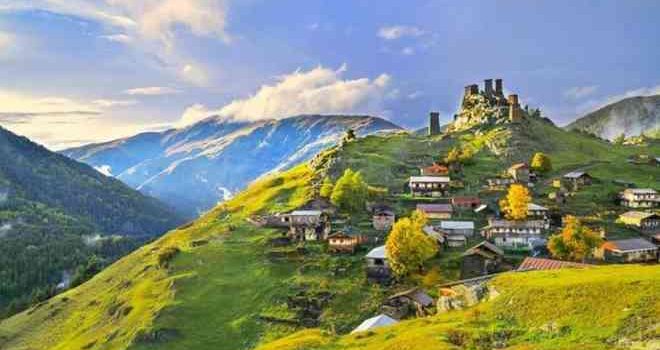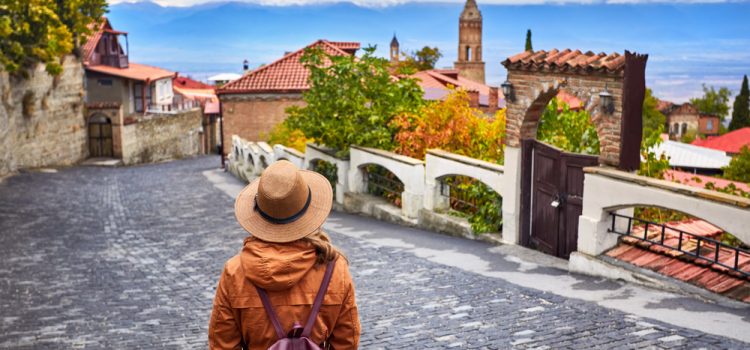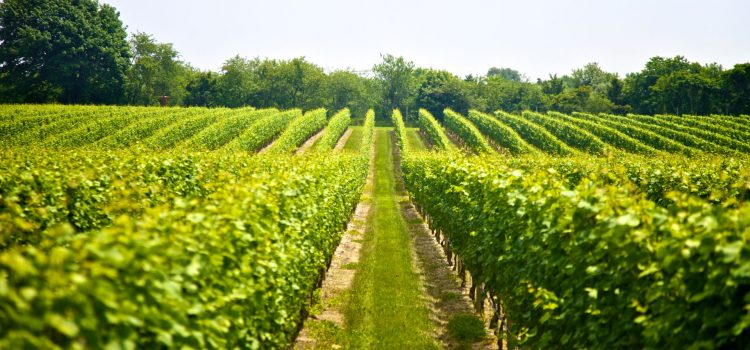Georgian Wine Presented in US Cities
Georgian wine, one of the major parts of the ancient culture of Georgia, has yet another time moved beyond the borders of its homeland. This time, it has been introduced to wider audiences in the USA, in the cities of New York, Chicago and Boston in particular.
At a presentation given by the top-sommelier Taylor Parsons and attended by Georgian wine producers, local entrepreneurs and media representatives, guests were given an opportunity to taste the wine and listen to a seminar on the modern wine industry.
The National Wine Agency of Georgia, the financial supporter of the event, selected the USA as a strategic and promising market for exporting Georgian wine. 354,000 bottles of wine were exported to the USA in the first half of 2019, which is a 90% increase in comparison with the same time period of the last year.
The presentation in the US cities was organized by the contractor marketing company of the National Wine Agency Marq Energie Consulting.
Source: www.georgiatoday.ge; By Ketevan Kvaratskheliya
Image source: National Wine Agency
The Daily Beast about Tusheti: The Last Wild Place in Europe
The Daily Beast has recently published an article about Tusheti, a historic region in northeast Georgia. Benjamin Kemper, the author of the article claims that the venue is the last wild place in Europe. He had visited Georgia many times but Tusheti had always been out of reach. The road to Tusheti is one of the most dangerous drives in the world.
“Even at the height of summer, it takes six hours of nauseous off-roading from the nearest town to reach the first Tushetian hamlets, and once you’ve arrived, you can all but forget creature comforts like cell service, internet, ATMs, and heat. But I was sold: The promise of an off-the-grid adventure in one of the last truly wild corners of Europe was too enticing to pass up,” reads the article about Tusheti.
The intact nature of Tusheti awaits visitors. The area is inhabited by “mountain goats, imperial eagles, brown bears, and, if you’re lucky, rare indigenous species like the Caucasian black grouse and East Caucasian tur, a goat-antelope with horns so enormous they look like they belong on a triceratops. There are even occasional, if uncorroborated, Persian leopard sightings.”
A herd of animals is moving forward on rocky slopes of the Great Caucasus Mountain and the scene can be observed from almost any place in Tusheti. The centuries-old towers will amaze visitors by their greatness and long-standing history. The towers used to be refuges protecting the locals from invaders or fatal avalanches.
“Medieval Tushetians did not mess around—they had their freedom to protect. From the earliest written records until well into to the 17th century, they enjoyed virtual autonomy as a tribal democracy. Although Tushetians coexisted fairly peacefully through the centuries with neighboring tribes such as the Chechens, Khevsurs, Lesghians, and Hinukhs, and traded often with them, they remained culturally distinct with their animist deities, transhumant lifestyle, fast-footed dances, and twangy dialect,” reads the article about the history of Tusheti.
Upon the hills, one can find a cluster of shrines called khatebi that is allegedly dedicated to Pagan-Christian demigods. Meanwhile, visiting a family in Tusheti will definitely involve tasting the traditional lamb-stuffed khinkali (Georgian dumpling).
Interested in the future of the region, Nugzar Idoidze, one of the locals of the village Omalo in Tusheti cheers the author up by saying that since Tushetians survived the Soviet pressure, they can survive anything.
The Daily Beast is an American news and opinion website focused on politics and pop culture.
source: www.Georgianjournal.ge
Georgia’s Historic Gem: Sighnaghi, The City of Love
Sighnaghi is a charming little town to the east of Tbilisi, located at an altitude of 740 meters above sea level. The town offers scenic views of the Alazani Valley and the Great Caucasian ridge, but not only this: Sighnaghi and its surroundings are being developed rapidly with more and more attractions popping up by the year.
When I first went to Sighnaghi in 2010, the town was already in the process of being restored. But even back then, a visit to Sighnaghi was a great experience in itself, taking into account its great historic wall, Sighnaghi National Museum, which houses a number of great masterpieces of Niko Pirosmani, and the town’s location close to the famous pilgrims’ destination, the Bodbe Monastery.
In 2010, Sighnaghi, in terms of infrastructure, didn’t have much to offer visitors aside from its great panoramic views and a few newly refurbished central streets. It had a few restaurants, one hotel and a couple of guesthouses. The rest of the town, with its crumbling facades, rusty roofs and pot-holed roads, reminded one heavily of a Potemkin village.
Since then, many things have changed. The city’s appearance, its roads, facades, and infrastructure have been restored or renovated; and throughout the town numerous restaurants and guesthouses have been established. Tourists from all over the world, including China, South Korea and Japan, now stream to Sighnaghi, meaning you’ll be hard put to find a household there which is not somehow involved in the tourism business.
“When I registered my guesthouse in the Booking.com system three years ago, I was the 34th on the list of Sighnaghi accomodation,” said Roman Beghashvili, a Sighnaghi guesthouse owner. “Now, there are around 150 on the list.”
Competition drives those in tourism to make their places more attractive to tourists. The ideas vary and are sometimes rather eccentric. There are plenty of picturesque cafés and hotels built beside the historic Sighnaghi wall. One of them, for instance, located on high stilts, seems to be hovering over the town, and offers guests the chance to take a paraglider flight or enjoy a drink overlooking the Alazani Valley and the historic wall, which is more than 4 km long. I’ve only had one comparable view of a medieval wall, and that was in the historic city of Avila in Spain.
“The first reminiscences of our town wall were found in chronicles of the 13th century,” said Mariam Guliashvili, the town historian. “But the construction of the wall which you can see now was ordered in the 18th century by King Irakli II. Our enemies used to attack our villages in the Alazani Valley: from the north came the Lezgins, from the south the Persians. They stole our women, children and livestock in order to sell them into slavery. To protect the inhabitants of the valley from the intruders, King Irakli II gave the order to construct this wall, which according to different documents was between 5 and 7 km long and had 23 towers and eight gates. Now we have over 4.5 km of it left, which comes close to the Small Wall of China with its 5 km length.”
Sighnaghi received its “city” status in 1770. At that time, it was already a vivid town of workmanship and trade with a population of up to 10,000 people, the majority being of Armenian origin. The King had ordered the Armenians to settle in Sighnaghi, as the Alazani Valley had previously been devastated by Shah Abbas, who took 100,000 Georgians to Persia.
In the following centuries, Sighnaghi became a great cultural and educational center, with its own theater and schools. Girls were educated in private schools established in the houses of rich citizens. In Soviet times, Sighnaghi was a flourishing tourist attraction with a big hotel located close to the town. The town was proud of its own Ethnographic Park, where archeologists from all over the country worked together on excavations. You still can visit this area now, if you take a walk in the beautiful and newly restored town park, which is romantically located on the slopes of Sighnaghi, behind the wall. Also worth a visit is the local cemetery, bearing many exciting stories of past times. With a little imagination, you can see the town history right there.
In order to inquire about recent tendencies in tourism, I headed to the Sighnaghi Information Center. The officer, Zurab Siprashvili, told me that just 10% of those who come to Sighnaghi actually visit the Information Center. He put the number of tourists that visited Sighnaghi last year at around 11,000 people, with the trend growing by the year. Most of the tourists come from Russia, Poland, Germany, France and Israel.
Sighnaghi’s location on a hill high above the ancient winemaking valley contributes to its increasing popularity. There are four big wineries as well as many wine degustation points in Sighnaghi.
From the town’s Deputy Mayor, Madonna Batiashvili, I learned about further plans concerning tourism and further development of the Sighnaghi region. “In future, we want our guests to stay longer in our region, so we plan to develop the nearby villages of Tsnori and Machkhaani. The latter is a unique village with an old theater from the 19th century and many historic houses, which are quite different from the usual Kakhetian houses. Machkhaani will soon be given the status of a Museum Village,” Batiashvili noted.
The town council plans to establish a new tourist route connecting Sighnaghi, Tsnori, Machkhaani and proceeding to Dedoplitskharo, a city with its own Pirosmani museum. Investments should be made in agricultural tourism for those visitors who enjoy nature, hunting and fishing, and who want to learn more about making churchkhela and baking Georgian bread. Several cable car routes should be established in order to connect some villages and allow visitors to enjoy great views of the Alazani Valley.
What else makes Sighnaghi so attractive for tourists? One of the town’s most renowned attractions is a quick marriage in the Marriage House, which operates 24/7.
“All you need is your passport and two witnesses,” Batiashvili told us. “Just imagine: I recently met a couple who became husband and wife early in the morning, at 4 am!”
Indeed, getting married is easy in Sighnaghi, as you don’t need to deal with bureaucracy at all. “Many of our citizens have become witnesses already, and they are now treated as relatives by the families of the newly married couples,” Batiashvili proudly said.
Source: www.Georgiatoday.ge; By Tatiana Montik
Forbes Features “Unique” Georgian Wines
Forbes published an article this week by contributor Lana Bortolot titled ”Why Georgian wines are Among the Most Unique on the Planet”.
Bortolot is a wine, food, and travel reporter who holds the Advanced Wine & Spirits Education Trust certificate and has covered wine regions in more than 16 countries.
In the article, Bortolot explores Georgian wine culture, the role of wine in modern Georgian society, and the technical side of Georgian wine. The piece is peppered with quotes from Georgian wine lovers:
“Even where we think a culture like France or Italy is so wine-centric, Georgians just take it to a whole different level—much deeper than what we’re exposed,” – Taylor Parsons
“There’s something very particular about how Georgians love wine,” he said. “It’s a little eccentric but then you start looking into it and once you do, you’re truly amazed—it’s such an integral part of the culture and everyday life.” – Noel Brockett
“One of the most important things about Georgian wines is that it’s a window into a culture that most of us as Westerners simply don’t have,” – Simon J. Woolf
Bortolot goes on to focus on orange or amber wines, a style growing in popularity worldwide that has long been part of Georgia’s tradition. She also recounts a legend, which said that, in ancient times, “soldiers wove a piece of grapevine into the chain mail protecting their chests, so when they died in battle, a vine sprouted not just from their bodies, but their hearts.”
The article introduces readers to several Georgian wine makers – locals and expats, high end factories and garage operations – celebrating the varied, inclusive culture of Georgian wine.
The article ends with a wine sampler. Bortolot recommends Kisi, Mtsvane, Rkatsiteli, Saperavi, and Tsinandali for beginners.
By Samantha Guthrie, Source: Georgiatoday.ge
Evidence of ancient wine found in Georgia a vintage quaffed some 6,000 years BC
Archaeologists are hard at work sifting through the dirt at a dig in Imiri, south-eastern Georgia.
The scientists believe that the site contains artefacts that could once and for all prove that Georgia is the oldest wine producing country in the world.
Eight thousand years ago, during the neolithic era, farming and agriculture were flourishing in the three villages that now make up the Shulaveri – Shumitepe Cultural ruins in Marneuli Valley.
And one of the products being grown and harvested proved to be grapes to make wine.
Stephen Batiuk is from the University of Toronto: “What is significant about this site is that it produced some of the earliest examples of domesticated grapes, which we believe were involved in the earliest production of wine. We know that a wine vessel was discovered in Shulaveri, which also provides evidence of early wine production. But here (Imiri site) wine could be produced even earlier taking wine production in Georgia all the way back to 6,000 BC.”
David Lordkipanidze, is director of Georgia’s National Museum:
“The aim of this project is to look at the history of agriculture. It’s not just only the question of the earliest wine and we have found here traces of very old wine making, but as well to look at the domestication of the weeds, of the different agricultural products, which shows that Caucasus and Georgia were part of this big geographical territory, the so called Fertile Crescent, where the earliest agriculture was appearing and first civilisations were spreading.”
The Fertile Crescent is a swathe of land stretching from upper Egypt to Mesopotamia, modern day Iraq, Kuwait and northeast Syria.
Source: Euronews.com






